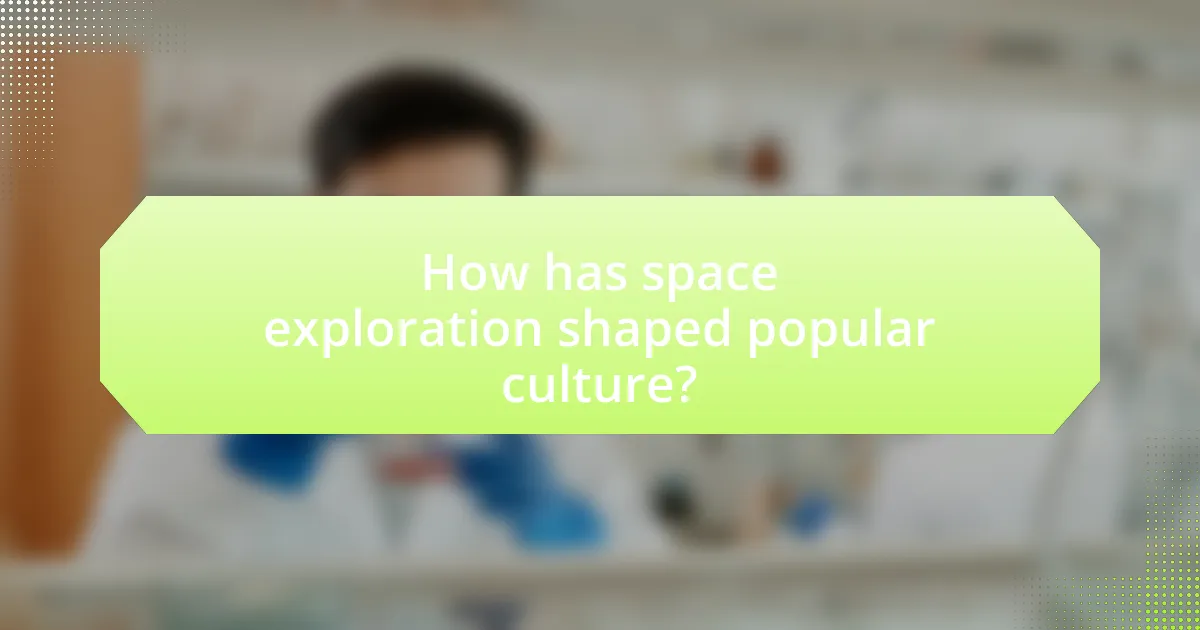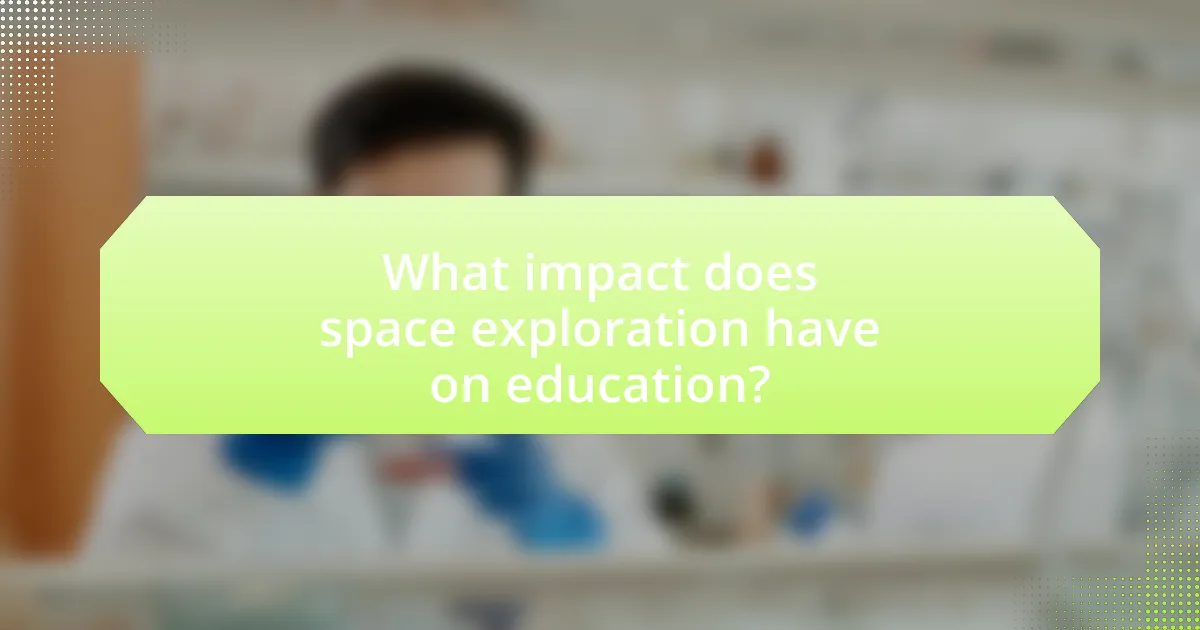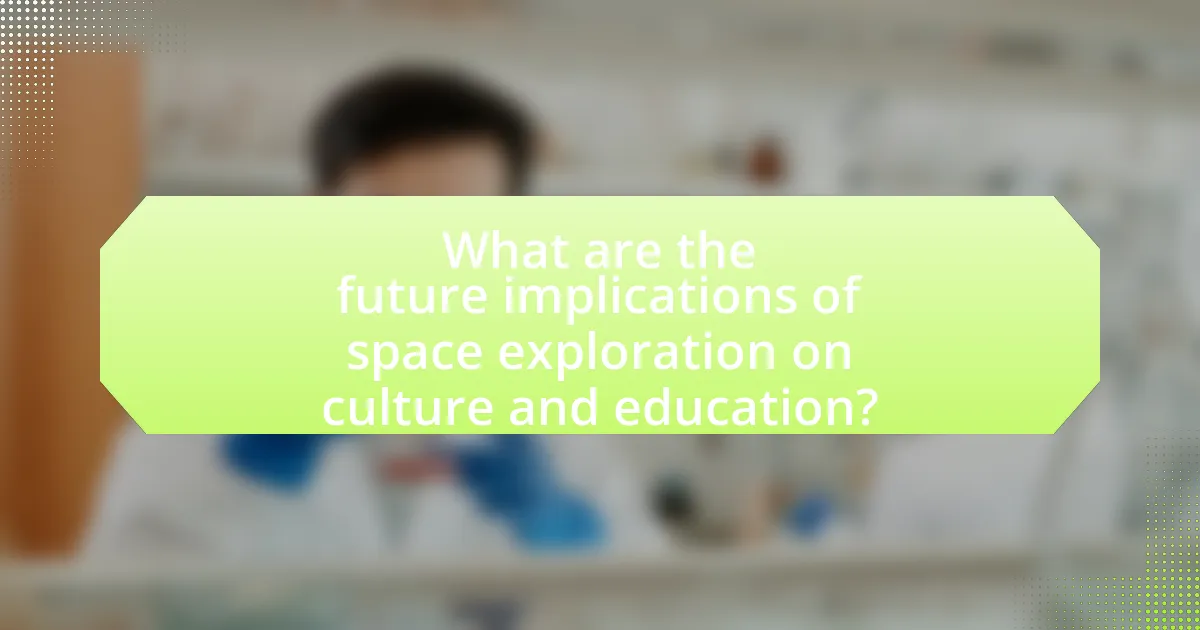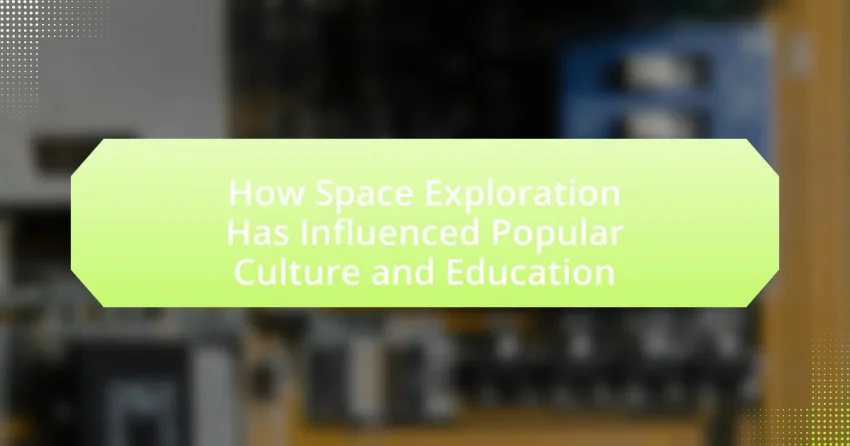Space exploration has profoundly influenced popular culture and education, shaping artistic expressions, media narratives, and public interest in science and technology. Key events, such as the Apollo moon landing, have inspired a surge in science fiction literature and films, while television shows and documentaries have engaged audiences with themes of adventure and the unknown. The integration of space exploration into educational curricula has enhanced STEM engagement, fostering critical thinking and problem-solving skills among students. Additionally, emerging technologies like virtual and augmented reality are set to further enrich cultural experiences and educational initiatives related to space, highlighting the ongoing impact of space exploration on society.

How has space exploration shaped popular culture?
Space exploration has significantly shaped popular culture by inspiring a wide range of artistic expressions, media narratives, and public interest in science and technology. The Apollo moon landing in 1969, for instance, not only marked a monumental achievement in human history but also catalyzed a surge in science fiction literature and films, such as “2001: A Space Odyssey,” which explored themes of space travel and human evolution. Additionally, television shows like “Star Trek” and “The X-Files” have incorporated space exploration into their storylines, reflecting societal hopes and fears about the future of humanity in the cosmos. This cultural impact is evidenced by the increased public engagement with STEM (Science, Technology, Engineering, and Mathematics) fields, as seen in educational initiatives and programs aimed at inspiring the next generation of scientists and engineers.
What are the key influences of space exploration on movies and television?
Space exploration significantly influences movies and television by shaping narratives, inspiring visual effects, and promoting scientific curiosity. The depiction of space travel in films like “2001: A Space Odyssey” and series such as “Star Trek” has not only captivated audiences but also sparked interest in real-world space missions, as evidenced by the increased public support for NASA following the release of these works. Furthermore, advancements in technology driven by space exploration have enhanced special effects in the entertainment industry, allowing for more realistic portrayals of space environments. This interplay between space exploration and media continues to inspire new generations to pursue careers in science and technology, demonstrating the profound impact of space on popular culture.
How have iconic films and series depicted space exploration themes?
Iconic films and series have depicted space exploration themes by showcasing humanity’s quest for knowledge, adventure, and the unknown. For instance, “2001: A Space Odyssey” explores the evolution of humanity and artificial intelligence in the context of space travel, reflecting the technological aspirations of the 1960s. Similarly, “Star Trek” presents a future where diverse species collaborate in space, promoting ideals of unity and exploration. These narratives often incorporate scientific concepts, such as gravity and the vastness of the universe, to engage audiences and inspire interest in real-world space missions, like NASA’s Apollo program, which aimed to land humans on the Moon. Through these portrayals, films and series have significantly influenced public perception and interest in space exploration.
What role do documentaries play in educating the public about space exploration?
Documentaries play a crucial role in educating the public about space exploration by providing accessible and engaging visual narratives that convey complex scientific concepts. These films often feature expert interviews, historical footage, and animations that illustrate the intricacies of space missions, making the information digestible for a broad audience. For instance, documentaries like “The Universe” series and “Apollo 11” have successfully popularized space science, leading to increased public interest and understanding of topics such as astrophysics and planetary exploration. Research indicates that visual storytelling enhances retention of information, which is vital for fostering a well-informed public regarding space initiatives and their implications for humanity.
In what ways has space exploration inspired literature and art?
Space exploration has inspired literature and art by providing themes of adventure, the unknown, and the human condition. Notable works such as Arthur C. Clarke’s “2001: A Space Odyssey” and Ray Bradbury’s “The Martian Chronicles” reflect humanity’s fascination with space and its implications for society. Additionally, visual art has been influenced by space missions, as seen in the works of artists like Chesley Bonestell, whose paintings of celestial bodies helped popularize space imagery in the mid-20th century. The Apollo missions also inspired a wave of artistic expression, with many artists creating pieces that capture the awe and wonder of space travel, demonstrating how scientific advancements can fuel creative exploration.
What are some notable books that explore space themes?
Notable books that explore space themes include “The Martian” by Andy Weir, which details an astronaut’s survival on Mars, and “2001: A Space Odyssey” by Arthur C. Clarke, which examines human evolution and artificial intelligence in space. Additionally, “Dune” by Frank Herbert explores interstellar politics and ecology on a desert planet, while “Contact” by Carl Sagan delves into the search for extraterrestrial intelligence. These works have significantly influenced popular culture and education by sparking interest in space science and exploration.
How have artists incorporated space exploration into their work?
Artists have incorporated space exploration into their work by using themes of cosmic imagery, technological advancements, and the human experience in relation to the universe. For instance, visual artists like Chesley Bonestell created detailed paintings of celestial bodies that influenced public perception of space in the mid-20th century. Additionally, contemporary artists such as Olafur Eliasson utilize installations that evoke the vastness of space, prompting viewers to reflect on humanity’s place in the cosmos. Furthermore, musicians like David Bowie have integrated space exploration into their lyrics and performances, notably in songs like “Space Oddity,” which narrates the journey of an astronaut. These artistic expressions not only celebrate scientific achievements but also provoke philosophical inquiries about existence and exploration.
How has space exploration influenced music and popular songs?
Space exploration has significantly influenced music and popular songs by inspiring themes of adventure, discovery, and the unknown. Artists have drawn from the imagery and concepts associated with space missions, such as the Apollo moon landings, which led to iconic songs like David Bowie’s “Space Oddity,” released in 1969, shortly after the first moon landing. This song encapsulated the feelings of isolation and wonder associated with space travel. Additionally, the 1970s saw the rise of disco and funk songs like “Rocket Man” by Elton John, which metaphorically explored the human experience through the lens of space travel. The influence extends to contemporary music as well, with artists like Coldplay and Muse incorporating space-related themes into their lyrics and visuals, reflecting humanity’s ongoing fascination with the cosmos. This connection between space exploration and music highlights how significant events in space history resonate within popular culture, shaping artistic expression and public imagination.
What are some famous songs that reference space exploration?
Famous songs that reference space exploration include “Space Oddity” by David Bowie, which tells the story of an astronaut named Major Tom, and “Rocket Man” also by Bowie, reflecting on the loneliness of space travel. Another notable song is “Intergalactic” by the Beastie Boys, which incorporates themes of space and adventure. Additionally, “Walking on the Moon” by The Police metaphorically explores themes of love and distance through the lens of space travel. These songs highlight the cultural fascination with space and its impact on music.
How do music festivals celebrate space themes?
Music festivals celebrate space themes through immersive experiences that incorporate visual art, themed performances, and interactive installations. For instance, festivals like Coachella and Electric Daisy Carnival feature stages designed to resemble celestial bodies, while artists often incorporate space-related visuals and narratives into their performances. Additionally, some festivals host workshops and discussions on space exploration, engaging attendees with topics such as astronomy and the future of human space travel. These elements not only entertain but also educate audiences about space, reflecting the broader influence of space exploration on popular culture.

What impact does space exploration have on education?
Space exploration significantly enhances education by inspiring interest in STEM (Science, Technology, Engineering, and Mathematics) fields. Programs like NASA’s Artemis and the Mars Rover missions provide real-world applications of scientific concepts, motivating students to engage with complex subjects. Research indicates that students exposed to space-related content demonstrate improved problem-solving skills and higher academic performance in science and math. For instance, a study by the National Science Foundation found that students participating in space-themed educational programs showed a 20% increase in science test scores compared to their peers. This connection between space exploration and educational outcomes underscores the importance of integrating space science into curricula to foster a new generation of innovators and thinkers.
How has space exploration been integrated into school curricula?
Space exploration has been integrated into school curricula through the inclusion of STEM (Science, Technology, Engineering, and Mathematics) programs that emphasize space science and technology. Educational initiatives, such as NASA’s educational resources and partnerships with schools, provide lesson plans, activities, and materials focused on space missions, astronomy, and the physics of space travel. For instance, NASA’s “Space Grant” program supports universities and colleges in developing educational programs that inspire students to pursue careers in aerospace and related fields. Additionally, the incorporation of space-themed projects and competitions, like the “CanSat” competition, allows students to engage in hands-on learning experiences that foster interest in space exploration.
What subjects benefit from the inclusion of space exploration topics?
Subjects that benefit from the inclusion of space exploration topics include science, technology, engineering, mathematics (STEM), environmental studies, and history. The integration of space exploration into these subjects enhances critical thinking, problem-solving skills, and fosters a deeper understanding of scientific principles. For instance, in STEM education, space missions like the Mars Rover have provided real-world applications of physics and engineering concepts, demonstrating the relevance of these subjects in practical scenarios. Additionally, environmental studies benefit from space exploration through the study of Earth from space, which aids in understanding climate change and resource management. Historical perspectives on space exploration also enrich history education by illustrating technological advancements and geopolitical dynamics during the Space Race.
How do educators use space missions to engage students?
Educators use space missions to engage students by incorporating real-world applications of science, technology, engineering, and mathematics (STEM) into their curricula. For instance, educators utilize NASA’s Artemis program to create lesson plans that involve problem-solving and critical thinking, allowing students to explore concepts such as gravity, propulsion, and the challenges of living in space. Research shows that hands-on activities related to space missions, such as building model rockets or analyzing data from Mars rovers, significantly enhance student interest and understanding in STEM fields. A study by the National Science Foundation found that students participating in space-related projects demonstrated a 30% increase in engagement and retention of scientific concepts compared to traditional teaching methods.
What role do space agencies play in educational outreach?
Space agencies play a crucial role in educational outreach by providing resources, programs, and initiatives that promote science, technology, engineering, and mathematics (STEM) education. For example, NASA’s educational programs, such as the “NASA STEM Engagement” initiative, offer students hands-on experiences and access to real data from space missions, fostering interest in space science and exploration. Additionally, space agencies often collaborate with schools and universities to develop curricula and educational materials that align with current space research, thereby enhancing the learning experience. These efforts are supported by statistics showing that students engaged in STEM activities related to space exploration demonstrate higher levels of interest in pursuing careers in these fields, contributing to a more scientifically literate society.
How do programs from NASA and ESA promote STEM education?
NASA and ESA promote STEM education through various initiatives that engage students and educators in hands-on learning experiences related to space exploration. Programs such as NASA’s Artemis Student Challenges and ESA’s Education Office initiatives provide opportunities for students to participate in competitions, workshops, and internships that focus on real-world applications of science, technology, engineering, and mathematics. For instance, NASA’s Artemis program encourages students to design and build experiments that could be used on lunar missions, fostering critical thinking and problem-solving skills. Additionally, ESA’s educational resources, including online courses and interactive materials, support teachers in integrating space science into their curricula, thereby enhancing student interest in STEM fields. These efforts are backed by research indicating that engagement in space-related activities significantly increases students’ motivation and understanding of STEM subjects.
What resources are available for teachers to incorporate space exploration into lessons?
Teachers can utilize a variety of resources to incorporate space exploration into lessons, including NASA’s educational materials, online platforms like the European Space Agency’s resources, and interactive simulations such as those offered by Stellarium. NASA provides lesson plans, videos, and activities that align with educational standards, making it easier for educators to integrate space topics into their curriculum. The European Space Agency offers resources that include educational games and activities focused on space science. Additionally, Stellarium allows teachers to simulate the night sky, enhancing students’ understanding of celestial events. These resources are designed to engage students and foster interest in space science, demonstrating the educational impact of space exploration.
How does public interest in space exploration affect educational initiatives?
Public interest in space exploration significantly enhances educational initiatives by increasing funding, resources, and student engagement in STEM (Science, Technology, Engineering, and Mathematics) fields. For instance, NASA’s Artemis program has inspired educational programs that promote hands-on learning experiences, such as robotics and coding workshops, aimed at K-12 students. According to a 2021 report by the National Science Board, increased public interest in space missions correlates with a 20% rise in STEM enrollment in universities, demonstrating that enthusiasm for space exploration directly influences educational pathways and opportunities.
What trends are emerging in educational programs related to space exploration?
Emerging trends in educational programs related to space exploration include increased integration of technology, interdisciplinary approaches, and a focus on hands-on learning experiences. Educational institutions are adopting virtual reality and simulation tools to enhance engagement and understanding of complex space concepts. Programs are also emphasizing collaboration across subjects such as science, technology, engineering, arts, and mathematics (STEAM) to foster a holistic understanding of space exploration. Furthermore, initiatives like NASA’s Artemis program are inspiring curricula that encourage students to participate in real-world projects, thereby promoting critical thinking and problem-solving skills. These trends reflect a growing recognition of the importance of space exploration in shaping future scientific and technological advancements.
How do community events and workshops enhance learning about space?
Community events and workshops enhance learning about space by providing interactive and engaging experiences that facilitate hands-on learning. These events often include activities such as telescope viewing, model rocket launches, and educational talks from experts, which allow participants to directly engage with astronomical concepts. Research indicates that experiential learning, such as that found in community workshops, significantly improves retention of information; for instance, a study published in the Journal of Science Education and Technology found that students who participated in hands-on science activities scored 30% higher on assessments compared to those who learned through traditional lectures. This demonstrates that community events and workshops effectively foster a deeper understanding of space through active participation and collaboration.

What are the future implications of space exploration on culture and education?
The future implications of space exploration on culture and education will likely include a significant increase in STEM engagement and a shift in cultural narratives surrounding humanity’s place in the universe. As space missions become more frequent and ambitious, educational institutions may integrate space-related topics into curricula, fostering interest in science, technology, engineering, and mathematics. For example, NASA’s Artemis program aims to return humans to the Moon and eventually send astronauts to Mars, which can serve as a catalyst for educational programs that inspire students to pursue careers in these fields. Furthermore, cultural representations in media, such as films and literature, will evolve to reflect the realities and possibilities of space exploration, influencing public perception and inspiring future generations.
How might advancements in space exploration continue to influence popular culture?
Advancements in space exploration will continue to influence popular culture by inspiring new narratives in film, literature, and art. For instance, the recent missions to Mars and the Artemis program aimed at returning humans to the Moon have sparked a resurgence of interest in science fiction, leading to films and books that explore themes of colonization and extraterrestrial life. Additionally, real-time data and images from space missions, such as those from the James Webb Space Telescope, have provided artists and creators with fresh material to interpret and visualize, further embedding space exploration into cultural expressions. The ongoing public engagement with space initiatives, such as SpaceX’s commercial flights, also fosters a sense of wonder and curiosity, which is reflected in popular media and educational content aimed at younger generations.
What emerging technologies could reshape media representations of space?
Emerging technologies such as virtual reality (VR), augmented reality (AR), and artificial intelligence (AI) have the potential to significantly reshape media representations of space. VR can create immersive experiences that allow users to explore celestial bodies and spacecraft in a simulated environment, enhancing educational outreach and engagement. AR can overlay digital information onto real-world views of the night sky, making astronomical data more accessible and interactive for the public. AI can analyze vast amounts of astronomical data, generating visualizations and narratives that can be shared through various media platforms, thus democratizing access to space exploration insights. These technologies collectively enhance the way space is represented in media, making it more engaging and informative for audiences.
How can virtual reality and augmented reality enhance cultural experiences related to space?
Virtual reality (VR) and augmented reality (AR) can significantly enhance cultural experiences related to space by providing immersive and interactive environments that allow users to explore celestial phenomena and historical space missions. These technologies enable users to experience simulations of space travel, such as walking on the Moon or navigating the International Space Station, which fosters a deeper understanding of space exploration’s impact on culture and education. For instance, VR experiences like “Apollo 11 VR” allow users to relive the historic lunar landing, while AR applications can overlay information about constellations and celestial events onto the night sky, making learning more engaging and accessible. Studies have shown that immersive experiences can improve retention of information and increase interest in STEM fields, highlighting the effectiveness of VR and AR in educational contexts related to space.
What future educational trends can we expect from ongoing space exploration?
Future educational trends from ongoing space exploration include increased emphasis on STEM (Science, Technology, Engineering, and Mathematics) education, interdisciplinary learning, and the integration of virtual and augmented reality in classrooms. As space missions, such as those by NASA and private companies like SpaceX, capture public interest, educational institutions are likely to adopt curricula that focus on space science and technology. For instance, the Artemis program aims to return humans to the Moon and establish a sustainable presence, which can inspire educational programs centered around lunar science and engineering. Additionally, the use of real-time data from space missions can enhance experiential learning, allowing students to engage with current scientific research and develop critical thinking skills. These trends are supported by the growing number of educational partnerships between space agencies and schools, which aim to provide resources and programs that inspire the next generation of explorers and innovators.
How might international collaborations in space exploration impact global education?
International collaborations in space exploration can significantly enhance global education by fostering cross-cultural exchanges and shared knowledge. These partnerships, such as the International Space Station program involving multiple countries, create opportunities for students worldwide to engage in collaborative projects, thereby promoting STEM (Science, Technology, Engineering, and Mathematics) education. For instance, NASA’s educational outreach programs often include international students in experiments and research, which has been shown to increase interest in science careers among participants. Furthermore, these collaborations can lead to the development of joint educational resources and curricula, making advanced scientific knowledge more accessible globally.
What skills will be essential for future generations in relation to space exploration?
Future generations will require skills in STEM (science, technology, engineering, and mathematics), critical thinking, and adaptability for space exploration. STEM skills are essential as they provide the foundational knowledge necessary for understanding complex space systems and technologies. For instance, NASA’s Artemis program emphasizes the need for engineers and scientists to develop new technologies for lunar exploration, highlighting the importance of these skills in real-world applications. Critical thinking enables individuals to solve problems and make decisions in unpredictable environments, which is crucial for missions that may encounter unforeseen challenges. Adaptability is vital as space exploration often involves rapidly changing conditions and the need to adjust plans accordingly. These skills collectively prepare future generations to tackle the challenges of exploring and utilizing space effectively.
What practical steps can individuals take to engage with space exploration in culture and education?
Individuals can engage with space exploration in culture and education by participating in community science programs, attending space-themed events, and utilizing educational resources. Community science programs, such as citizen science projects, allow individuals to contribute to real scientific research, fostering a deeper understanding of space. Attending events like planetarium shows, space fairs, or lectures by astronauts and scientists provides direct exposure to space topics and encourages public interest. Additionally, utilizing educational resources from organizations like NASA or the European Space Agency, which offer free online courses and materials, enhances knowledge and promotes discussions about space exploration’s impact on society and culture.
